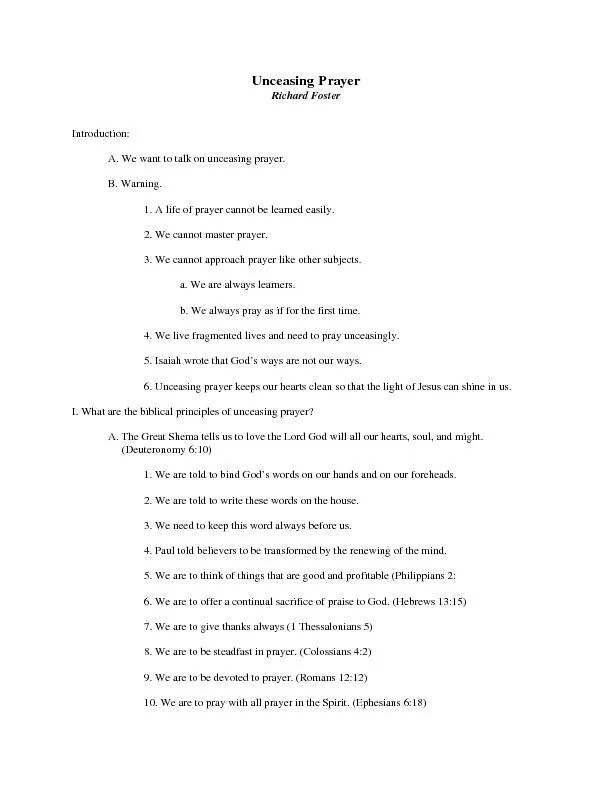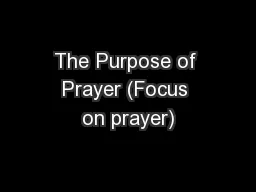PDF-Unceasing Prayer
Author : luanne-stotts | Published Date : 2016-08-17
Richard Foster Introduction A We want to talk on unceasing prayer B Warning 1 A life of prayer cannot be learned easily 2 We cannot master prayer 3 We cannot approach
Presentation Embed Code
Download Presentation
Download Presentation The PPT/PDF document "Unceasing Prayer" is the property of its rightful owner. Permission is granted to download and print the materials on this website for personal, non-commercial use only, and to display it on your personal computer provided you do not modify the materials and that you retain all copyright notices contained in the materials. By downloading content from our website, you accept the terms of this agreement.
Unceasing Prayer: Transcript
Richard Foster Introduction A We want to talk on unceasing prayer B Warning 1 A life of prayer cannot be learned easily 2 We cannot master prayer 3 We cannot approach prayer li. of SALVATION: From: The Way of the Pilgrim 2 The following excerpt is from The book the Way of a Pilgrim. those involved in the discussion are: the Pilgrim the starets (a spiritual e Prayer is not the psychological crutch of a weakling.. Prayer is not the act of an emotionally insecure person.. Prayer is not the last resort when all else fails.. Prayer is not the “911 Emergency Line” in times of trouble.. Vol. 5 Testimony p.112. Those who will put on the whole armor of God and . devote. sometime . every. . day. to . meditation. and . prayer. and to the . study of the Scriptures. . will be connected with heaven and will have a saving, transforming influence upon those around them.. Resource Slides. Loving God, whose son Jesus Christ. called all who were thirsty. to come to him, believe and drink.. . Look in mercy on your people living in dry lands, and. struggling to survive without access to safe drinking water.. The MILLION HOUR Prayer Campaign. For Unreached Peoples. NO . 24. Church of God World Missions/Church of God Prayer Ministries – www.cogwm.org www.praycog.org. The Mandate:. Without faith, it is impossible to please God. He that comes to God must believe that he is, and that he is a rewarder of those who diligently seek him . The MILLION HOUR Prayer Campaign. For Unreached Peoples. NO . 23. Church of God World Missions/Church of God Prayer Ministries – www.cogwm.org www.praycog.org. The Mandate:. Now the men were about twelve in all … so the word of the Lord grew mightily and . A. doration. C. onfession. T. hanksgiving. S. upplication. The Power of Prayer (Push us to pray). Forgiveness. Peace. Strength. Opportunity. Boldness . Laborers. Wisdom. Healing. The Principles of Prayer (Pray correctly). The Interior Way. “. Prayer . is the journey to the kingdom: the arrival is union with God. The kingdom is not far from us, but is within . us”. What is Prayer?. “Lord, teach us to pray.” (Luke 11:1). Martin Luther. Matthew 6:5-13 . (page 787 on pew Bibles). “And when you pray, do not be like the hypocrites, for they love to pray standing in the synagogues and on the street corners to be seen by others. Truly I tell you, they have received their reward in full. But when you pray, go into your room, close the door and pray to your Father, who is unseen. Then your Father, who sees what is done in secret, will reward you. And when you pray, do not keep on babbling like pagans, for they think they will be heard because of their many words. . Relationship with God. Different types of prayer. The prayer of faith. Different types of prayer. The prayer of faith. The prayer of agreement. Different types of prayer. The prayer of faith. The prayer of request. humility . is the foundation of prayer, Only when we humbly acknowledge that "we do not know how to pray as we ought," are we ready to receive freely the gift of prayer. "Man is a beggar before God." . (James 5:16, NKJV). “avails much” . - translated from a Greek word that means to have power, to have force, to be strong.. 1. Prayer Avails Much. “effective, fervent” . - translated from the Greek word . Diocese of Philadelphia, PA| . October, 18 . 2018. President, Institute for Pastoral Leadership. Diocese of Pitsburgh. Director of . Curriculum . Development. Sophia . Institute . for . Teachers. Michel Therrien, S.T.L., S.T.D. Introduction (prayer, . . Our Father. ). Definition:. 1. Theological Dictionary. A privilege and an obligation of the Christian where we communicate with God. It is how we convey our confession (.
Download Document
Here is the link to download the presentation.
"Unceasing Prayer"The content belongs to its owner. You may download and print it for personal use, without modification, and keep all copyright notices. By downloading, you agree to these terms.
Related Documents














